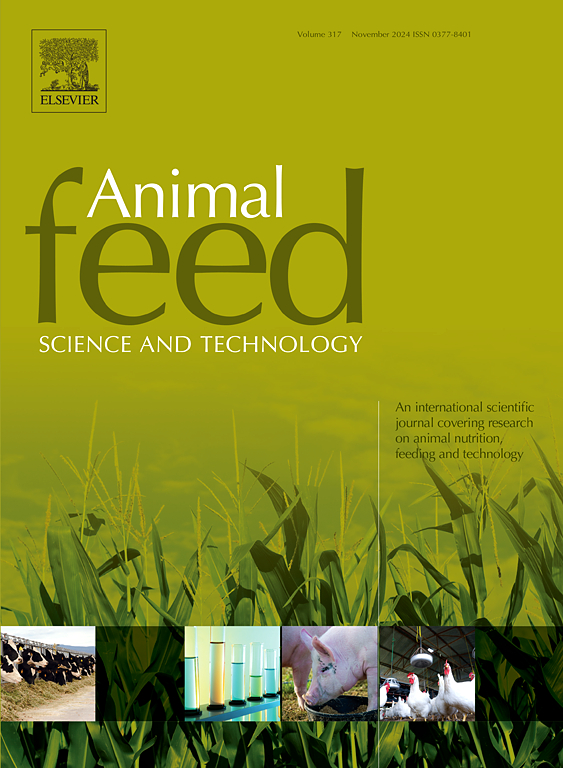Replacing fishmeal with hydrolysates from whole forage-fish or pacific krill combined with soy protein concentrate in Japanese seabass (Lateolabrax japonicus) diets
IF 2.7
2区 农林科学
Q1 AGRICULTURE, DAIRY & ANIMAL SCIENCE
引用次数: 0
Abstract
Marine protein hydrolysates are preferred alternative for fishmeal due to their good nutritional value and functional characteristics. The current study was conducted to investigate effects of replacing fishmeal with Pacific krill hydrolysate (HPK) or whole forage-fish hydrolysate (HWF) on growth performance, feed utilization, whole-body composition, nutrient retention and digestibility in Japanese seabass Lateolabrax japonicus. Eight iso-nitrogenous (∼ 430 g kg−1) and iso-energetic (∼ 200 MJ kg−1) diets were formulated including a fishmeal supplemented diet (FMC, 200 g kg−1 fishmeal) and seven fishmeal replacement groups, with 50, 100, 150 and 200 g kg−1 fishmeal being replaced by 25, 50, 75 and 100 g kg−1 HPK or HWF, and namely HPK25, HPK50, HPK75, HPK100, HWF25, HWF50 and HWF75, respectively. After 70 days of feeding, no significant differences were observed in WGR and FCR among fish fed different diets, but FI significantly decreased in HPK100. Moreover, diet HWF75 improved feed utilization as evidenced by lower FCR (0.86) than the other diets (0.89–0.91). Contents of protein and lipid in whole-body and retentions of nitrogen and energy significantly decreased with increasing supplementation levels of marine protein hydrolysate (HPK and HWF) from 50 to 75 g kg−1. Apparent digestibility coefficients (ADCs) of nutrients including protein and Met significantly increased with increasing HPK supplementation level, with fish fed HPK100 showing highest ADCs of protein and Met. Notably, HPK significantly increased ADCs of protein and energy than HWF. Diet containing 75 g kg−1 marine protein hydrolysate significantly decreased CHOL and HDL-C than 25 g kg−1 supplementation level. Furthermore, the full-length cDNA sequence of pept1 was cloned and characterized in Lateolabrax japonicus. The pept1 cDNA sequence is 3118 bp, encoding a putative protein of 728 amino acids, with predominant expression in the foregut. Highest expression level of pept1 in foregut was observed in HPK25 and HWF25, and significantly higher than the other diets. Overall, this study clarified a combination of HWF or HPK with soy protein concentrate by a mixing ratio of 1:1 effectively decreased supplementation level of fishmeal from 200 to 100 g kg−1 in extruded practical feed for juvenile Lateolabrax japonicus.
在日本鲈鱼(Lateolabrax japonicus)饲料中,用全饲料鱼或磷虾的水解物与大豆蛋白混合替代鱼粉
海洋蛋白水解物具有良好的营养价值和功能特性,是鱼粉的首选替代品。本试验旨在研究用磷虾水解液(HPK)或全饲料-鱼水解液(HWF)替代鱼粉对日本鲈鱼生长性能、饲料利用率、全鱼组成、营养物质潴留和消化率的影响。配制了8种等氮(~ 430 g kg−1)和等能(~ 200 MJ kg−1)饲料,包括鱼粉补充饲料(FMC, 200 g kg−1鱼粉)和7个鱼粉替代组,分别用25、50、75和100 g kg−1 HPK或HWF替代50、100、150和200 g kg−1鱼粉,分别为HPK25、HPK50、HPK75、HPK100、HWF25、HWF50和HWF75。饲喂70 d后,不同饲料对鱼的增重率和饲料效率无显著影响,但HPK100的FI显著降低。饲粮HWF75提高了饲料利用率,饲料转化率(0.86)低于其他饲粮(0.89 ~ 0.91)。随着海洋水解蛋白(HPK和HWF)添加水平从50增加到75 g kg−1,全鱼蛋白质和脂肪含量以及氮和能量的保留显著降低。蛋白质和蛋氨酸等营养物质的表观消化率系数(ADCs)随HPK添加水平的增加而显著升高,其中以HPK100饲料的蛋白质和蛋氨酸表观消化率最高。与HWF相比,HPK显著提高了蛋白质和能量的adc。饲粮中添加75 g kg−1海洋蛋白水解物比添加25 g kg−1显著降低了CHOL和HDL-C。此外,还克隆了pept1的全长cDNA序列,并对其进行了鉴定。pept1 cDNA序列为3118 bp,编码728个氨基酸的蛋白,主要表达于前肠。在HPK25和HWF25中,前肠中pept1的表达水平最高,且显著高于其他饲粮。综上所述,本研究明确了以1:1的混合比例将HWF或HPK与大豆蛋白精料组合,可以有效地将膨化实用饲料中鱼粉的添加量从200降至100 g kg−1。
本文章由计算机程序翻译,如有差异,请以英文原文为准。
求助全文
约1分钟内获得全文
求助全文
来源期刊

Animal Feed Science and Technology
农林科学-奶制品与动物科学
CiteScore
6.00
自引率
6.20%
发文量
266
审稿时长
3 months
期刊介绍:
Animal Feed Science and Technology is a unique journal publishing scientific papers of international interest focusing on animal feeds and their feeding.
Papers describing research on feed for ruminants and non-ruminants, including poultry, horses, companion animals and aquatic animals, are welcome.
The journal covers the following areas:
Nutritive value of feeds (e.g., assessment, improvement)
Methods of conserving and processing feeds that affect their nutritional value
Agronomic and climatic factors influencing the nutritive value of feeds
Utilization of feeds and the improvement of such
Metabolic, production, reproduction and health responses, as well as potential environmental impacts, of diet inputs and feed technologies (e.g., feeds, feed additives, feed components, mycotoxins)
Mathematical models relating directly to animal-feed interactions
Analytical and experimental methods for feed evaluation
Environmental impacts of feed technologies in animal production.
 求助内容:
求助内容: 应助结果提醒方式:
应助结果提醒方式:


